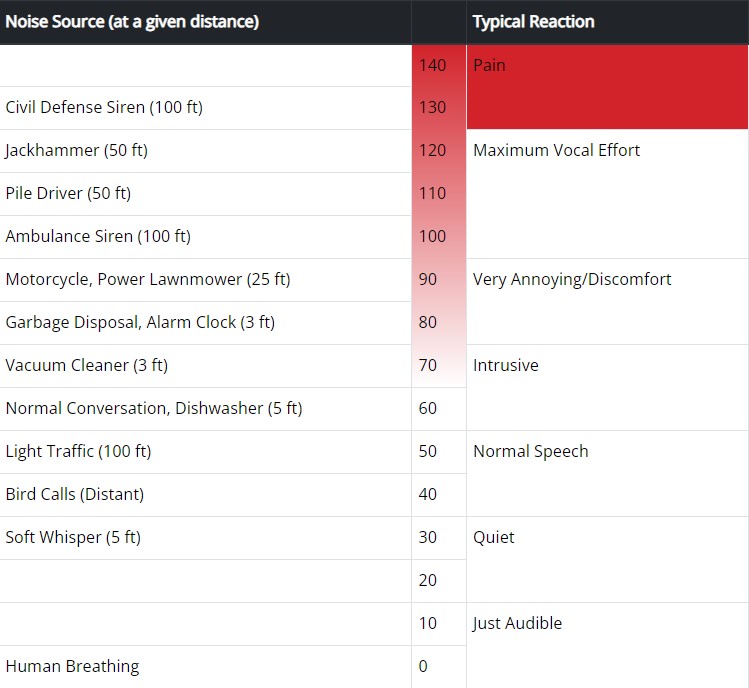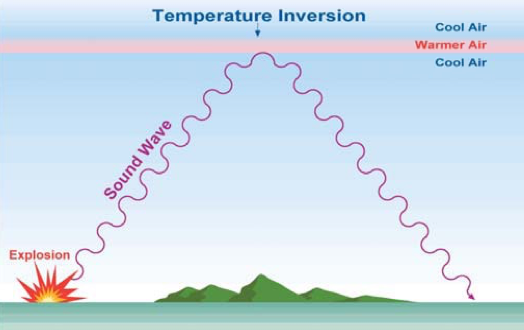Introduction
While noise itself is something that everyone has experienced and recognizes, the technical concepts applied in noise management can be difficult for installation personnel and communities to understand. Establishing a basic and common understanding of noise concepts helps military installations and surrounding communities work together to address noise issues more effectively.
Decibels and Weighting
The standard for the loudness of sound or noise levels is a quantity known as the
“decibel (dB).” The human ear is not uniformly sensitive to all frequencies of sound. Most common sound sources are measured using A-weighted decibels (dBA). The A-weighting corresponds to the ear’s sensitivity and deemphasizes very high and low sound frequencies to only reflect the frequencies that people actually hear. The military typically uses A-weighting to describe sound from generators, aircraft, and general transportation. For reference, a normal voice has a sound level of approximately 60 dBA, and a busy highway can have a noise level of over 85 dBA.

C-weighted decibels (dBC) quantify sounds containing large amounts of low-frequency energy. Although people cannot hear low frequencies well, they may feel vibrations that low-frequency energy generates. As a result, large caliber weapons firing, and detonations are assessed with C-weighted dBs to better describe the sound and vibrations that people may experience.
Cumulative vs. Single Event Sound Levels
Federal, state, and local agencies use a set of common metrics and measurements to describe noise when assessing land use compatibility and conducting noise studies and noise management. Each metric or measurement is used differently depending on the source or type of sound to ensure community exposure is appropriately measured and addressed. The differences in these metrics often confuse both installation personnel and communities, who may not realize that different types of noise are assessed in different ways.
Noise and Vibration
While artillery firing or explosives activities may seem to shake the ground, the vibration felt in neighbors’ homes is typically caused by airborne sound waves that act on external surfaces of a home, causing it to vibrate. This vibration may cause annoyance and concern; however, it is very unlikely that vibration from normal military activities will result in structural damage to homes.
Day-Night Average Sound Levels
“Day-night average sound level” (DNL) is the most widely-used metric to describe, assess, and predict long-term noise exposure. The military uses DNL as the basis for determining land use compatibility for noise associated with aviation, demolition, and large caliber weapons. As with the decibel, DNL can also be weighted to better describe sound based on the type of the source. A-weighted DNL (ADNL) is used to describe noise from sound sources such as aircraft or transportation. C-weighted DNL is used to describe low-frequency sources such as large caliber weapons and detonations. DNL represents an average of all noise activities conducted throughout the day, and is usually averaged over an extended period of time. For land use planning, DNL is usually averaged over a year to include days of light and heavy training loads, as well as periods with no activity. DNL is most often used to describe and plan for persistent military activities, which is the best-known method for assessing and predicting long-term community exposure.
Day-Night Average Sound Level (DNL)
DNL is a 24-hour average sound level that includes a 10-dB adjustment, or “penalty”, for activity occurring between 10 p.m. and 7 a.m. The 10-dB penalty considers that people are more sensitive to noise during these hours, when sounds are more noticeable and may be considered more intrusive.

The concept of daily average sound level can be difficult to explain to communities and stakeholders. It is important to understand that an average daily sound level accounts for all periods of activity, as well as inactivity, in a 24-hour period. As depicted, a measured daily average sound level for a small number of loud events may be equivalent to a large number of quieter events. Similarly, several relatively quiet events may not increase overall daily average sound levels.
Peak or Maximum Sound Levels
Although DNL is an effective metric for assessing land use compatibility or the average of all noise events in a day, DNL may not be the best method of describing community annoyance associated with occasional loud events and their potential impact on communities. DNL accounts for the total noise exposure a community experiences over a period of time. The DoD often uses supplemental metrics such as “unweighted” peak sound levels and maximum sound levels to assess noise levels of impulsive and single events. This is necessary because the DNL (average) noise metric may understate the intensity of the impulsive events (small arms, artillery, tank gun, explosive detonations) since DNL averages noise peaks with ambient quiet times. For example, the average noise level is irrelevant to a mother upset about a child awakened from naps by aircraft operations or tank firing. Supplemental metrics are sometimes a better predictor than DNL for determining noise impacts and likelihood of complaints.
Community Noise Equivalent Level (CNEL)
For military installations located in the State of California, CNEL is used in place of DNL as the primary metric for describing long-term noise exposure. CNEL, like DNL, applies a 10-dB penalty for activities occurring between 10 p.m. and 7 a.m., as well as an additional 5-dB penalty for activities occurring between 7 p.m. and 10 p.m.
Single-Event Noise
DNL does not provide a clear depiction of maximum and peak noise levels from loud, single events. When planning specific noisy activities, the DoD compares the expected noise level to standard guidelines. It also factors in and analyzes weather and other elements that influence how sound travels. Information in the following tables can be compared with expected noise levels to determine whether there is a risk for adverse impacts on the community.
Influences on Sound Propagation
One of the more challenging aspects of managing noise is the way sound travels and propagates under different weather, wind, terrain, and even temperature conditions. Under the changing weather conditions, it is possible that a sound source can be barely detectable one day, but very loud and annoying the next.

The image illustrates how temperature inversions bends (refracts) the sound created by a typical explosion. The sound waves from the explosion initially travel upward, but the inversion reflects the sound back down toward the ground, generating high noise levels many miles away. Noise levels at that distance would otherwise be much lower.
Weather conditions have the largest influence on sound and significantly affect sound propagation. Wind, temperature, and cloud cover influences how far sound travels and how loud it will be at the receiver’s location. Sound levels are typically higher downwind than upwind from the source. Temperature variations can also make distant sounds much louder and be heard at further distances than normal. In certain conditions, variations in temperature can act as a boundary for sound, trapping it close to the ground. This can create areas of high intensity sound far from the source. For example, on most days it may be possible to conduct military activities without disturbing neighboring communities. On another day, cloud cover and temperature variation can result in significantly increased noise levels from the same activities at the same location. In the case of blast noise, sound levels can vary by over 40 decibels at the receiver over the course of hours for the same activity.
When assessing noise at military installations, DoD relies on acoustic modeling software that can accurately simulate the effects of sound propagation and determine sound levels under varying conditions. Noise modeling tools can help DoD and communities with land use planning and optimize the timing of activities to minimize community impacts.
